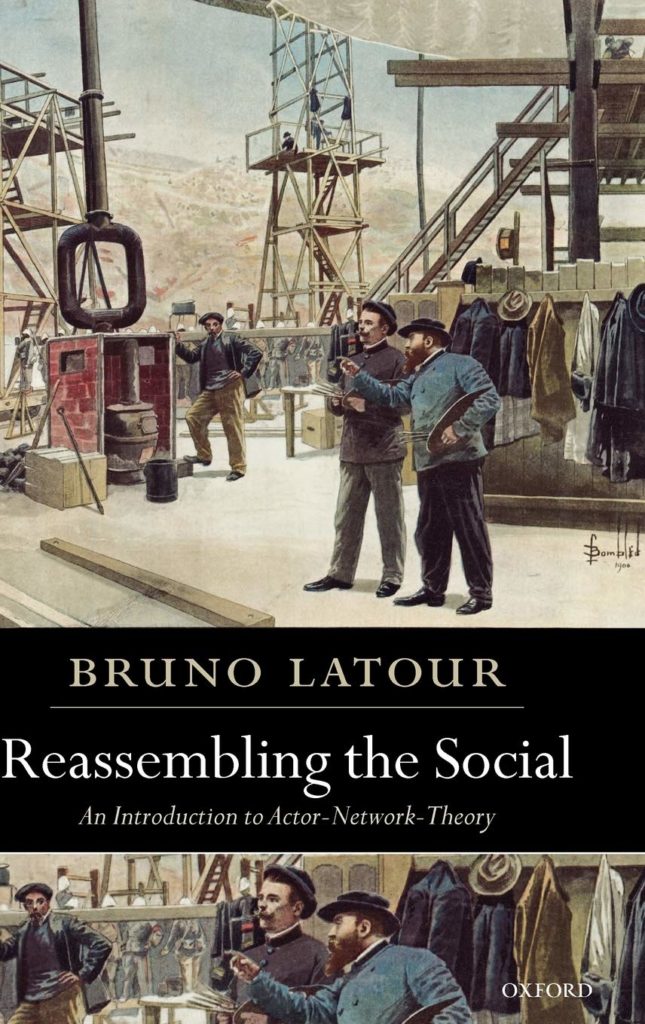
Agência não humana em Latour (2005)
LATOUR, Bruno. 2005. Reassembling the social: an introduction to actor-network theory. Oxford: Oxford University Press.
NONHUMAN AGENCY as ANT TEST
Although there is no clear litmus test for ANT membership, some ad hoc and make- shift ones may be devised. […] One of them is the precise role granted to non-humans. They have to be actors […] and not simply the hapless bearers of symbolic projection. But this activity should not be the type of agency associated up to now with matters of fact or natural objects. So if an account employs either a symbolic or a naturalist type of causality, there is no reason to include it in the ANT corpus even though it might claim to be. Conversely, any study that gives non-humans a type of agency that is more open than the traditional natural causality—but more efficient than the symbolic one—can be part of our corpus, even though some of the authors would not wish to be associated in any way with this approach. (Latour 2005:10)
THE SURPRISE FROM WHICH SOCIOLOGISTS OF ASSOCIATIONS WISH TO START (nonhumans explain asymmetries)
[T]here might exist many metaphysical shades between full causality and sheer inexistence. In addition to ‘determining’ and serving as a ‘back- drop for human action’, things might authorize, allow, afford, encourage, permit, suggest, influence, block, render possible, forbid, and so on. ANT is not the empty claim that objects do things ‘instead’ of human actors: it simply says that no science of the social can even begin if the question of who and what participates in the action is not first of all thoroughly explored, even though it might mean letting elements in which, for lack of a better term, we would call non-humans. This expression, like all the others chosen by ANT is meaningless in itself. It does not designate a domain of reality. It does not designate little goblins with red hats acting at atomic levels, only that the analyst should be prepared to look in order to account for the durability and extension of any interaction. The project of ANT is simply to extend the list and modify the shapes and figures of those assembled as participants and to design a way to make them act as a durable whole. […] For sociologists of associations, what is new is not the multiplicity of objects any course of action mobilizes along its trail—no one ever denied they were there by the thousands; what is new is that objects are suddenly highlighted not only as being full-blown actors, but also as what explains the contrasted landscape we started with, the overarching powers of society, the huge asymmetries, the crushing exercise of power. This is the surprise from which sociologists of associations wish to start instead of considering, as do most of their colleagues, that the question is obviously closed and that objects do nothing (Latour 2005:72)
AFFORDANCE
This is why the notion of affordance, introduced in James G. Gibson (1986), The Ecological Approach to Visual Perception, has been found so useful. The multiplicity of modes of action when dealing with technology—hard and soft—is marvellously followed by Suchman, Plans and Situated Actions, C. Goodwin and M. Goodwin (1996), ‘Formulating planes: Seeing as a situated activity’, and Bernard Conein, Nicolas Dodier and Laurent Thévenot (1993), Les objets dans l’action. De la maison au laboratoire. (Latour 2005:72 nota 83)
ANTHROPOCENTRIC BIAS
There is a bit of anthropocentric bias in using the expression non-humans. (Latour 2005:72 nota 84)
SYMMETRY & AGENCY
ANT is not, I repeat is not, the establishment of some absurd ‘symmetry between humans and non-humans’. To be symmetric, for us, simply means not to impose a priori some spurious asymmetry among human intentional action and a material world of causal relations. There are divisions one should never try to bypass, to go beyond, to try to overcome dialectically. They should rather be ignored and left to their own devices, like a once formidable castle now in ruins. […] This interest for the object has nothing to do with a privilege given to ‘objective’ matter in opposition to ‘subjective’ language, symbols, values, or feelings. […] [T]he ‘matter’ of most self-proclaimed materialists does not have a great deal to do with the type of force, causality, efficacy, and obstinacy non-human actants possess in the world. ‘Matter’ […] is a highly politicized interpretation of causality. […] [W]e should be ready to inquire about the agency of all sorts of objects. But since objects have such poor and constricted roles in most of the social sciences, it’s very difficult to extend their original activity to other types of material like documents, writings, charts, files, paper clips, maps, organizational devices, in brief intellectual technologies. As soon as some freedom of movement is granted back to non-humans, the range of agents able to participate in the course of action extends prodigiously and is no longer restricted to the ‘middle size dry goods’ of analytical philosophers. What makes ANT difficult to grasp is that it fills in precisely the space that is emptied by critical sociologists with the damning words of ‘objectification’ and ‘reification’. (Latour 2005:76-7)
MANUAL DE INSTRUÇÕES
See Donald A. Norman (1988), The Psychology of Everyday Things, Donald Norman (1993), Things that Make Us Smart; Madeleine Akrich and Dominique Bouiller (1991), ‘Le mode d’emploi: genése et usage’; and Chapter 6 in Garfinkel (2002), Ethnomethodology’s Program: Working Out Durkheim’s Aphorism.
A JOINT DISSOLUTION OF THE COLLECTIVES “HUMANS-SOCIETY” and “NONHUMANS-NATURE”
This is the reason why I have abandoned most of the geometrical metaphor about the ‘principle of symmetry’ when I realized that readers concluded from it that nature and society had to be ‘maintained together’ so as to study ‘symmetrically’ ‘objects’ and ‘subjects’, ‘non-humans’ and ‘humans’. But what I had in mind was not and, but neither: a joint dissolution of both collectors. The last thing I wanted was to give nature and society a new lease on life through ‘symmetry’. (Latour 2005:76 nota 89)
‘Society’ and ‘Nature’ do not describe domains of reality, but are two collectors that were invented together, largely for polemical reasons, in the 17th century. (Latour 2005:110)
Both monsters are born in the same season and for the same reason: nature assembles non-humans apart from the humans; society collects humans apart from the non-humans. As I have shown elsewhere at length, both are twin freaks generated to stifle the very possibility of a rightful composition of the collective.
(Latour 2005:164)
DISTRIBUTED COGNITION
Distributed cognition, situated knowledge, history of intellectual technologies, science studies, administrative sciences, and social accounting have each in its own way multiplied the range of objects engaged in making interactions longer lasting and further reaching. This long trend to materialize non-material technologies goes back to Jack Goody (1977), The Domestication of the Savage Mind; see Geoffrey C. Bowker and Susan Leigh Star (1999), Sorting Things Out: Classification and Its Consequences; Paolo Quattrone (2004), ‘Accounting for God. Accounting and Accountability Practices in the Society of Jesus (Italy, 16th–17th centuries)’; and the now classical work of Michel Foucault (1973), The Birth of the Clinic. An Archaelogy of Medical Perception. (Latour 2005:76 nota 90)
MORALITY & TECHNOLOGY
Between a car driver that slows down near a school because she has seen the ‘30 MPH’ yellow sign and a car driver that slows down because he wants to protect the suspension of his car threatened by the bump of a ‘speed trap’, is the difference big or small? Big, since the obedience of the first has gone through morality, symbols, sign posts, yellow paint, while the other has passed through the same list to which has been added a carefully designed concrete slab. But it is small since they both have obeyed something: the first driver to a rarely manifested altruism—if she had not slowed down, her heart would have been broken by the moral law; the second driver to a largely distributed selfishness—if he had not slowed down his suspension would have been broken by the concrete slab. Should we say that only the first connection is social, moral and symbolic, and that the second is objective and material? No. But, if we say that both are social, how are we going to justify the difference between moral conduct and suspension springs? They might not be social all the way through, but they certainly are collected or associated together by the very work of road designers. One cannot call oneself a social scientist and pursue only some links—the moral, legal, and symbolic ones—and stop as soon as there is some physical relation interspersed in between the others. That would render any enquiry impossible. (Latour 2005:77-8)
MAKE NON-HUMANS TALK
To be accounted for, objects have to enter into accounts. If no trace is produced, they offer no information to the observer and will have no visible effect on other agents. They remain silent and are no longer actors: they remain, literally, unaccountable. Although the situation is the same for groups and agencies—no trial, no account, no information—it is clearly more difficult for objects, since carrying their effects while becoming silent is what they are so good at as Samuel Butler noted.94 Once built, the wall of bricks does not utter a word—even though the group of workmen goes on talking and graffiti may proliferate on its surface. Once they have been filled in, the printed questionnaires remain in the archives forever unconnected with human intentions until they are made alive again by some historian. Objects, by the very nature of their connections with humans, quickly shift from being mediators to being intermediaries, counting for one or nothing, no matter how internally complicated they might be. This is why specific tricks have to be invented to make them talk, that is, to offer descriptions of themselves, to produce scripts of what they are making others—humans or non-humans—do. (Latour 2005:79)
A METODOLOGIA TAR SERVE PARA CORRIGIR A ILUSÃO ANTROPOMÓRFICA
But still, there is a difference: once humans become mediators again, it is hard to stop them. An indefinite stream of data springs forth, whereas objects, no matter how important, efficient, central, or necessary they may be, tend to recede into the background very fast, interrupting the stream of data—and the greater their importance, the faster they disappear. It does not mean they stop acting, but that their mode of action is no longer visibly connected to the usual social ties since they rely on types of forces chosen precisely for their differences with the normal social ones. Speech acts always look comparable, compatible, contiguous, and continuous with other speech acts; writing with writing; interaction with interaction; but objects appear associable with one another and with social ties only momentarily [Nota 96 (p.80): Both impressions are only superficially true. A human’s course of action is never homogeneous and there is never a technology that is so well organized that it runs automatically. And yet, the practical difference remains for someone who is carrying out the inquiry.]. This is quite normal since it is through their very heterogeneous agencies that social ties have been provided with completely different shape and figures—normal but tricky. (Latour 2005:79-80)
SOCIAL x NON-SOCIAL
When a bicycle hits a rock, it is not social. But when a cyclist crosses a ‘stop’ sign, it becomes social. When a new telephone switchboard is installed, this is not social. But when the colors of telephone sets are discussed, this becomes social because there is, as designers say, ‘a human dimension’ in the choice of such a fixture. When a hammer hits a nail, it is not social. But when the image of a hammer is crossed with that of a sickle, then it graduates to the social realm because it enters the ‘symbolic order’. Every object was thus divided in two, scientists and engineers taking the largest part— efficacy, causality, material connections—and leaving the crumbs to the specialists of ‘the social’ or ‘the human’ dimension. (Latour 2005:83)
PRIMITIVE CLASSIFICATION (sociogists as savages)
It would be incredible if the millions of participants in our courses of action would enter the social ties through three modes of existence and only three: as a ‘material infrastructure’ that would ‘determine’ social relations like in the Marxian types of materialism; as a ‘mirror’ simply ‘reflecting’ social distinctions like in the critical sociologies of Pierre Bourdieu; or as a backdrop for the stage on which human social actors play the main roles like in Erving Goffman’s interactionist accounts. None of those entries of objects in the collective are wrong, naturally, but they are only primitive ways of packaging the bundle of ties that make up the collective. None of them are sufficient to describe the many entanglements of humans and non-humans. (Latour 2005:84).
CONSTRUÇÃO = LABOR(ATÓRIO)
In plain English, to say something is constructed means that it’s not a mystery that has popped out of nowhere, or that it has a more humble but also more visible and more interesting origin. Usually, the great advantage of visiting construction sites is that they offer an ideal vantage point to witness the connections between humans and non-humans. Once visitors have their feet deep in the mud, they are easily struck by the spectacle of all the participants working hard at the time of their most radical metamorphosis.108 This is not only true of science but of all the other construction sites, the most obvious being those that are at the source of the metaphor, namely houses and buildings fabricated by architects, masons, city planners, real estate agents, and homeowners.109 The same is true of artistic practice.110 The ‘making of’ any enterprise—films, skyscrapers, facts, political meetings, initiation rituals, haute couture, cooking—offers a view that is sufficiently different from the official one. Not only does it lead you backstage and introduce you to the skills and knacks of practitioners, it also provides a rare glimpse of what it is for a thing to emerge out of inexistence by adding to any existing entity its time dimension. Even more important, when you are guided to any construction site you are experiencing the troubling and exhilarating feeling that things could be different, or at least that they could still fail—a feeling never so deep when faced with the final product, no matter how beautiful or impressive it may be. (Latour 2005:88-9)
CONSTRUÇÃO = EXISTÊNCIA
[N]o one would bother to say that a skyscraper, a nuclear plant, a sculpture, or an automobile is ‘constructed’. This is too obvious to be pointed out. The great questions are rather: How well designed is it? How solidly constructed is it? How durable or reliable is it? How costly is the material? Everywhere, in technology, engineering, architecture, and art, construction is so much a synonym for the real that the question shifts immediately to the next and really interesting one: Is it well or badly constructed? (Latour 2005:89)
A NATUREZA É O MAIOR DE TODOS OS ARTIFÍCIOS
[S]cience offered the most extreme cases of complete artificiality and complete objectivity moving in parallel. There could be no question that laboratories, particle accelerators, telescopes, national statistics, satellites arrays, giant computers, and specimen collections were artificial places the history of which could be documented in the same way as for buildings, computer chips, and locomotives. And yet there was not the slightest doubt that the products of those artificial and costly sites were the most ascertained, objective, and certified results ever obtained by collective human ingenuity. This is why it was with great enthusiasm that we began using the expression ‘construction of facts’ to describe the striking phenomenon of artificiality and reality march- ing in step. […] Facts were facts— meaning exact—because they were fabricated—meaning that they emerged out of artificial situations. (Latour 2005:89-90)
SOCIAL AS ASSOCIATION (fazer-fazer)
Social is nowhere in particular as a thing among other things but may circulate everywhere as a movement connecting non-social things. […] [S]ocial is back as association. […] We don’t know yet how all those actors are connected, but we can state as the new default position before the study starts that all the actors we are going to deploy might be associated in such a way that they make others do things. (Latour 2005:107)
REALISMO FANTÁSTICO
To our great surprise, once the artificial boundary between social and natural was removed, non-human entities were able to appear under an unexpected guise. For instance, rocks might be useful to knock an idealist back to his senses, but rocks in geology seemed to be much more varied, much more uncertain, much more open, and deploy many more types of agencies than the narrow role given to them in empiricist accounts. Steel desks offer a great opportunity for angry realists to thump the table in the name of ‘material constraints’ so as to bring sociologists back to reality, but laminated steel in metallurgy offers so many conundrums on the ways material resistance may occur that there is almost no relation between what positivist philosophers and material scientists call ‘matter’.The inflexible drive of genetic make-up may be great for socio-biologists to ridicule the socialist dream of nurturing a better humanity, but genes in biogenetics take so many contradictory roles, obey so many opposite signals, are ‘made up’ of so many influences that if there is one thing that cannot be done with them it is to silence an adversary. Computers might offer an advertisement for the best example of hype, but chips in computer science require vast institutions in order to live up to their reputation as ‘formal machines’. Everywhere, the empirical multiplicity of former ‘natural’ agencies overflows the narrow boundary of matters of fact. There exists no direct relation between being real and being indisputable. (Latour 2005:111)
PURIFICAÇÃO LATOURIANA
In ‘society’ we learned to distinguish the associations—which we kept—from a substance made of social stuff—which we rejected. Similarly, in ‘nature’ we are going to keep the deployment of reality and reject its premature unification into matters of fact. If it was a mistake to jump from the idea of association to the conclusion that they are phenomena made of social stuff, it’s a symmetric error to conclude from an interest in non-humans that they will look like matters of facts (Latourt 2005:115)
PESSOAS (C.Sociais) =/= OBJETOS (C.Naturais)
[Y]ou can never stifle the voice of non-humans but you can do it to humans. People have to be treated much more delicately than objects because their many objections are harder to register. Whereas subjects easily behave like matters of fact, material objects never do.176 This is why the question of what is a good account is so much more crucial for the social than for the natural sciences. (Latour 2005125)
TRACEABILITY
The meandering path through which most of the ingredients of action reach any given interaction is traced by the multiplication, enrollment, implication, and folding of non-human actors. If the analyst is not allowed to exert some right of pursuit through multiple types of agencies, then the whole question of local and global becomes intractable. But as soon as non-human agents are brought in, another set of connections appears (Latour 2005:193)
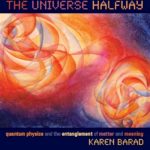
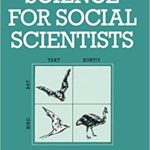
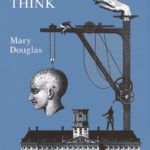
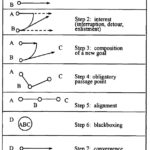
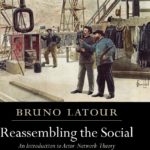
 LaSPA is located at the Institute of Philosophy and Human Sciences (
LaSPA is located at the Institute of Philosophy and Human Sciences (